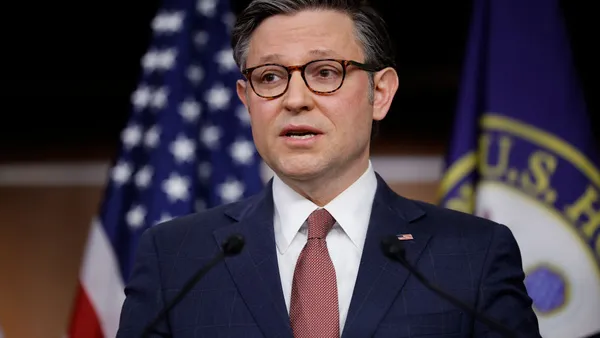Dive Brief:
- The familiar but inconspicuous work-study programs on campuses could be fine-tuned to improve retention, helping students who need income while providing them with sought-after career-readiness skills and training opportunities, according to a new report.
- The review of such programs by NASPA–Student Affairs Administrators in Higher Education recommends the programs become a higher priority for campus leaders and have clear standards. It also suggest they be better promoted, supervised and evaluated with strong data.
- The report highlights how work-study programs can address a "working student dilemma" of growing concern by tying opportunities to earn income with the chance to develop marketable skills.
Dive Insight:
The report touches on ways the work-study program can help tackle two nagging issues in higher education: career readiness and retention. Students who see value in these jobs and make connections through them to the campus, peers and professionals may have a better experience in college and be more likely to stay enrolled, it notes.
It also suggests career-readiness be a goal, something work-study programs can help with by emulating the real-life hiring process — such as requiring a resume and an interview, offering an orientation to the position and conducting an exit interview. Those steps can also help the institution gather data on the student work experience.
In a 2017 report, nonpartisan think tank New America made a set of recommendations for improving the federal work-study program. Among them, it suggests structuring jobs around career and educational goals rather than menial tasks, as well as increasing work-study funding to community colleges and more equitably distributing the money nationwide. A 2016 report from the National Association of Student Financial Aid Administrators (NASFAA) made similar recommendations.
NASPA's report gives several examples of successful work-study initiatives. One is the University of Iowa's GROW (Guided Reflection on Work) program, which has been replicated on more than 100 campuses since it launched in 2009. Students are placed in work-study jobs with responsibilities aligned with learning outcomes that are determined by the institution's Division of Student Life, which oversees student success initiatives. Student employees and their supervisors use four questions to guide conversations about their ability to connect their work experience to classroom learning.
A recent survey by the program found student workers who talked with their supervisors about the connections between their job and coursework were more likely to report having gained communication skills, problem-solving abilities and other work-related habits.
Clemson University, the report notes, offers an on-campus internship program that places undergraduates in positions related to their majors or areas of interest, pays them and offers academic credit.
Other programs called out in the report include the use of a coordinator to oversee the initiative and to manage the student experience and employer connections. NASFAA, too, recommends dedicating a staff member to implementing work-study programs.
The Federal Work-Study program was called out in the Trump administration's 2020 budget proposal, which asks to reorient it around "workforce and career-oriented training" but offers few details on how it would achieve that goal. James Kvaal, president of The Institute for College Access and Success, cautioned that doing so would be an expense in and of itself, The Chronicle of Higher Education reported, running counter to the overall cuts requested.
Past requests to reduce funding for the work-study program have caught flak for decreasing the number of students who could participate.
About 700,000 students participate in the Federal Work-Study program each year, according to the National College Access Network (NCAN), a figure it says represents less than 10% of Pell Grant recipients.













